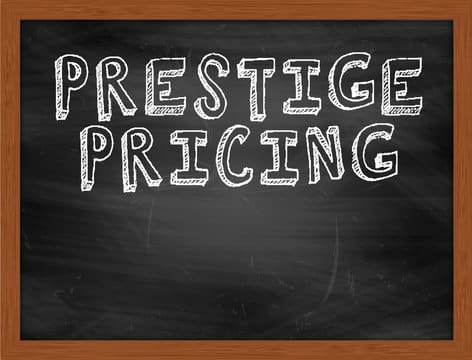The pricing strategy you choose has repercussions on your business. If you undervalue your goods by pricing them too low, you risk undervaluing yourself. Meanwhile, if you choose a strategy like Prestige Pricing, your company could reap the benefits. Let’s quickly go some vital information including prestige pricing examples.
Of course, you must strike a balance. As we know, this entails looking after the company’s bottom line while also remembering your customers’ needs.
What is the meaning of prestige pricing?
Prestige Pricing, also known as Premium Pricing, is a pricing technique based on psychological factors. Its aim is to overprice goods in order to give the impression that they are of higher quality to consumers and shoppers. That’s why it’s also known as “Image Pricing” by retailers, as it aims to project an image of exclusivity.
It’s simple to figure out which goods or brands use this pricing strategy. Many of them can be found in high-end stores all over the world. Consider the jewelry, fashion, and perfume industries, as well as automobile manufacturers.
It’s worth noting, however, that using a pricing strategy other than prestige pricing will damage a luxury product or premium brand. Take a look at what happened to Tiffany & Co in the 1990s. To cater to a wider audience, the luxury jewelry and niche store wanted to sell a more affordable jewelry collection.

They did just that, and it was well-received. In reality, it is much too common. Although revenues and profits increased, the brand’s exclusivity was quickly lost, and it began to struggle. They’ve since learned their lesson and increased their prices, and the brand’s reputation has improved.
Of course, they aren’t the only company to do so. There are many examples of luxury brands trying to cater to a wider audience and failing miserably. A brand can become nothing more than a commodity product if it follows the wrong pricing strategy.
Lowering a product’s price, on the other hand, could hurt sales of a premium brand. Since the value of certain commodities is so strong, any reduction in their price would reduce demand. Veblen products are those for which demand rises as prices rise.
When do you use this pricing strategy in your company?
Although prestige pricing is most often associated with premium brands that express luxury, it is not exclusive to high-end retailers. In reality, there is a point to be made that this pricing strategy will work for small businesses in some cases. Below, we’ll clarify why we believe that.
For the time being, we’ll look at a few scenarios in which a prestige pricing strategy is most beneficial:
When you’re first getting your product off the ground
Prestige pricing is a good technique to use when bringing a new product to the market. This is because no one knows anything about your product, so now is the best time to introduce it.
Of course, any marketing campaign can be used to complement this tactic and further “whet the appetite” of shoppers. If you’ve done your job correctly, you’ll have generated the impression that the product’s quality warrants the price you’re charging.
However, you must consider your target customer and price your product appropriately. It all comes down to the balance. In other words, determine the highest price at which your customers will not balk or hesitate before purchasing. You can use retail analytics to assist you in this situation.
As a side note, make sure that any claims about a premium product’s quality aren’t just marketing talk. Your customers will find out immediately, tarnishing your brand’s name. If this happens, customers will be hesitant to purchase from you in the future.
When the product is one-of-a-kind and cannot be duplicated
If you sell or produce exclusive goods that customers can’t find anywhere else, you’re in a good position to use a prestige pricing strategy. In reality, ask any retailer, and we’re confident they’ll all agree.
This approach should be followed to maximize revenue and profits for such a commodity.
Take note: If you’re a small retailer trying to stand out, this plan will help you do just that. This is because having a one-of-a-kind product gives you a bargaining chip. You’ll be in an even better spot if you match the higher asking price with high quality and build a good reputation.
Furthermore, taking the legal path and trademarking your product would improve your status even further. It is totally advisable . This is particularly important if you’ve recently released a new product that has become so successful that others want to emulate your success.
If there is a limit to how many products you made
Although offering a unique product helps you to raise your prices and pursue a prestige pricing strategy, limiting the number of goods available works just as well, if not better.
A limited supply, screams “exclusivity” more than anything else. After all, by restricting the amount of goods produced, you’re telling your consumers that if they buy it, they’ll be getting something that only a few people have.
It’s no surprise that there are so many limited-edition specials and new items on the market. These terms have a lot of influence. Of course, if used solely for marketing purposes, it could lose its meaning. But that’s a topic for another discussion.
Also, restricting the output of a high-quality commodity allows it to be labeled as a “superior good.” For the sake of clarification, a superior good is not associated with ‘normal goods.’ It is defined as such because it is both scarce and expensive. It’s also not the antonym for “inferior products.”
Regardless of whether you’re pricing your goods high or when you decide to do so, the rule is to build enough demand around the product to justify its price. If you are unable to do so, you should reconsider your pricing plan.
The benefits and drawbacks of using a reputation pricing approach
There are advantages and disadvantages of any approach. These advantages and disadvantages in the case of prestige pricing help to explain why larger retailers are better off using this approach.
This isn’t to suggest that you can’t use this technique if you’re a small retailer. As previously said, there are several cases in which you can at least attempt it.
Benefits
A higher level of visibility
If you want to stand out from the crowd and entice people to purchase your goods, premium pricing will help you do so.
The explanation for this is simple: by advertising that your goods are more costly, you create the impression that they are of higher quality in the minds of your consumers. There’s also a psychological connection between luxury and premium pricing that can’t be overlooked.
Even if you haven’t completely persuaded customers of your product’s quality, many will visit your store or pick up a product to see what all the fuss is about.
Profit margins that are higher
Increased profit margins are an obvious consequence of rising the product’s exposure and enhancing its brand value. Although you might have less sales, you can almost certainly make up for it with a higher profit per sale.
Of course, you must be certain that you’ve chosen the ideal price point. So, since this plan will cost you a lot of money in terms of ads, you’ll need to balance your books. More on that later.
DrawBacks
Contrary to popular belief, there are a number of disadvantages to using this method.
An increase in marketing budget
While this pricing strategy allows for higher profit margins, it comes at a high cost. This is where it can become a stumbling block for small businesses. It’s more difficult because consumers won’t buy a product they’ve never heard of, particularly if it’s expensive.
Of course, considering the variety of marketing outlets available, a small retailer on a tight budget can be able to get around this obstacle in the short term. In the long run, you do not have to think about this if you’ve invested in the right platforms and have high-profile individuals endorsing your goods.
A small number of customers
A premium brand or luxury item is only sold to a select group of people. As a result, your consumer base will be small. That doesn’t rule out the possibility of expanding your customer base.
However, rather than growing to include a larger audience, you can expand sideways to allow more of your target market to purchase your goods. After all, if you sell exclusive items, or at least pretend to, you don’t want to end up like any other luxury brand that has lost its identity.
Prestige Pricing Examples
Nike is a great example of a business that successfully employs prestige pricing, which is a pricing technique in which rates are set higher than normal because cheaper prices would hurt profits. Other examples of prestige pricing include; Gucci, Versace, Prada, Apple and so on.
What Is an Example of Prestige Pricing?
Nike is an excellent illustration of a business that successfully employs prestige pricing, a pricing strategy in which prices are set higher than usual since lower prices will actually hinder sales.
What Is a Prestige Pricing Strategy?
When a business sells a product at a high price point to give customers the idea that it is of high value, the practice is known as prestige pricing, premium pricing, or image pricing. Most of the time, companies do this to appeal to customers who are interested in portraying a prestigious or higher position.
What Is Prestige in Marketing?
Prestige pricing, also called “image pricing,” is a branding and marketing strategy that uses higher prices to suggest that the product is of higher quality. In other words, a company will set a price that is on purpose high to attract customers who want to be associated with a luxury brand.
What Is the Difference Between Price Skimming and Prestige Pricing?
The goal of prestige pricing is to keep the price of a product high for as long as possible, unlike the goal of a skimming strategy, which is to keep the price high for as short a time as possible. In this case, prestige is linked to value, which is a natural reason to buy something.
- MARKET RISKS: Best Practices and Easy Guide with Examples
- PENETRATION PRICING POLICY: HOW YOU CAN GAIN MARKET ENTRY
- MARKET GROWTH: Definition, Calculations, Rates, Strategies (Simplified)
- INSTITUTIONAL ADVERTISING: Best Practices with Examples (Updated)
- Can you Buy a Money Order with a Credit Card? (Pros & Cons)
- Best easy advertising campaign guide (+free strategy)







